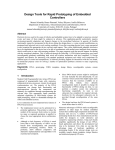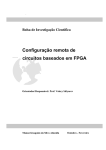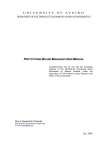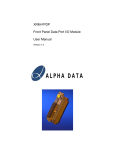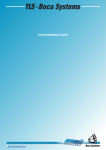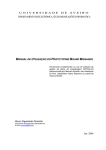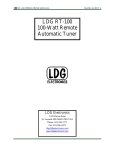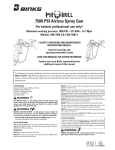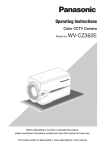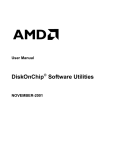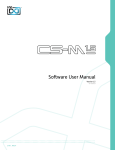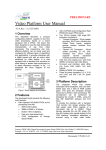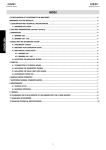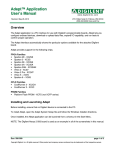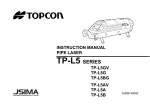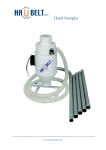Download 1 - Universidade de Aveiro › SWEET
Transcript
Design Tools for Rapid Prototyping of Embedded Controllers Manuel Almeida, Bruno Pimentel, Valery Sklyarov, Iouliia Skliarova Department of Electronics, Telecommunications and Informatics, IEETA University of Aveiro, 3810-193 Aveiro, Portugal [email protected], [email protected], [email protected], [email protected] Abstract Electronic devices used in the scope of robotics and embedded systems have to be adapted to numerous external events and many of them might be unknown in advance. This application-specific particularity requires environment-specific adaptation and frequent changes in the predefined behaviour. In general, all feasible functionality cannot be incorporated in the device during the design phase, i.e. some eventual modifications are postponed until physical tests in real working conditions. Even after executing physical tests, some unexpected events (requiring the appropriate device reaction) might appear. Thus, either sophisticated adaptable electronics has to be implemented or the device has to be able to communicate with another more intelligent host computer, which would assist to cope with emerging problems. The paper suggests tools that provide support for dealing with the considered situations. This is achieved through the following: 1) FPGA-based prototyping core board (reconfigurable platform) establishing both wired and wireless interactions with host computers; 2) Design templates and libraries for interacting with standard peripheral equipment and widely used components for different types of control and computations; 3) Software providing support for interactions with the core board; 4) Intellectual property cores for solving a number of optimization problems common to many engineering applications. Keywords: FPGA, prototyping, VHDL templates, design library, reconfigurable systems, remote configuration 1 • Since FPGA-based systems might be configured not only statically but although dynamically then we can construct virtual systems than might require more resources than resources available on FPGA chip. Indeed since dynamic reconfiguration makes it possible to change functionality of FPGA during run time, we can partition a complex system into subsystems functioning sequentially. As soon as one subsystem has completed the required functionality, hardware for the subsequent subsystem can be provided through reconfiguration of the same FPGA; • The design lead time for FPGA-based system is much shorter than for ASICs. Introduction Modern Field Programmable Gate Arrays (FPGA) are composed of programmable logic cells, memories, arithmetical devices, processors, circuits for advanced synchronization, etc. The majority of the FPGA components can change their functionality and interconnections between the components can arbitrarily be established both through reprogramming the relevant chip. This opportunity opens practically unlimited capabilities of FPGA-based systems for rapid prototyping, which is a demanded technique for robots and embedded systems. Let us summarize the most important basic features of FPGA-based systems: • The implemented circuit can be optimized for a particular application. This permits to reduce the number of the necessary clock cycles, to execute (as many as required) operations in parallel, to chose the most appropriate device architectures, etc.; • Although a clock frequency of FPGAs is much slower than for ASICs we can benefit from optimized architectures and practically unlimited prototyping facilities, which, in particular, allow different competitive and alternative implementations and algorithms to be examined and compared; Numerous advantages of FPGAs make reconfigurable platforms an ideal target for modern embedded systems that combine high computation demands with dynamic task sets [4]. A number of FPGA-based prototyping boards have been manufactured and they enable the designers to verify alternative and competitive engineering solutions. Using such boards simplifies significantly the design of new FPGAbased applications and allows the development lead time to be shortened. Very often we can take full advantage range of hardware capabilities of prototyping boards if the relevant design tools are provided, namely design templates, design libraries and intellectual property (IP) cores. The paper discusses one of the approaches in this scope Note that a large number of available FPGA-based prototyping systems makes it difficult to find the best choice for a particular application and, as a rule, it is necessary to find a compromise between the required hardware/software resources and the price. Taking into account the fact that the majority of prototyping boards/systems include many typical components (such as memories, liquid crystal displays - LCDs, standard interfaces, etc.) it is very difficult to find a board optimally targeted to the particular application, i.e. such a board that contains only those elements that are required for a particular design problem and no other components, which just increase the cost and occupy the space. The paper suggests a technique permitting to overcome this problem, which has been achieved through the design of an extendable set of hardware/software tools easily retargeted to different engineering application areas. Any particular problem can be solved using just the selected subset from the considered set, which includes only the needed hardware/software components and excludes all the other available components. In case if the desired components are not available they can be constructed easily. • Simulation in computer using general purpose and application-specific software; • Hardware/software co-simulation [5] in such a way that the developed FPGA-based controller interacts with virtual sensors and actuators displayed on PC monitor screen (see figure 1) and their activity (much like the activity of analogous sensors and actuators in physical systems) is supported by the relevant software models. • Hardware libraries that enable the designers to communicate with typical peripheral devices (see the right-hand part of figure 1). This is very helpful for debugging purposes. Simulation of an execution unit in virtual mode on PC monitor screen interface with PC Extension hardware for interactions with sensors and actuators In general, the suggested tools possess the following distinctive features: • Socket The core FPGA can be configured using wired (USB) and in future wireless (Bluetooth) interfaces, which makes the prototyping system ideal for remote applications, such as that are needed for robotics and embedded systems; • The developed software/hardware components provide support for both dynamic onboard reconfiguration and remote wireless reconfiguration and/or interaction; • The design process is supported by various supplied tools, such as hardware description language (VHDL in particular) templates, design libraries and IP cores. Some of them are targeted to the remote control and the reconfigurability. The remainder of this paper is organized in six sections. Section 2 describes FPGA-based embedded controllers. Section 3 considers FPGA-based prototyping systems. Section 4 shows how remote interactions with the board can be established. Sections 5, 6 present the developed software tools, hardware and language templates, IP cores and design libraries. The conclusion is in section 7. 2 USB module FPGA-based embedded controllers The main objective of the proposed tools is illustrated in figures 1 and 2. We would like to divide the design process of an embedded controller into two stages. The first stage is verification and debugging of the developed application at different levels of abstraction, namely: Figure 1: Using wired interfaces for testing and debugging purposes. After the controller has been tested it can be connected to the proper physical system (see figure 2). At this stage we can use the same prototyping board replacing USB interface block with Bluetooth wireless interface block, which can be inserted in the same socket. After that we still have support for debugging through remote interactions. This permits many useful functions to be implemented, such as: • Reading and verifying intermediate states; • Remote reconfiguration; • Intellectual assistance from the host computer, which evidently possesses more powerful hardware/software resources; • Hardware support for virtual capabilities allowing the controller to be constructed on an FPGA that does not have sufficient hardware resources to accommodate all the required functionality, etc. the controller’s In order to implement the considered technique many different software/hardware components have been developed, namely: • Drivers for USB/Bluetooth interfaces; • Software supporting functions, illustrated in Figures 1 and 2; • Design templates permitting dynamically reconfigurable circuits to be constructed; • Design libraries to support interfaces with typical peripheral devices (see figure 1); • IP cores for solving numerous optimization problems formulated over binary and ternary matrices; • Hardware/software tools for data compression and decompression. Embedded controller Wireless communication first section contains a bitstream that has to be preloaded to FPGA in order to allow the following set of operations: 1) transferring an application-specific bitstream to the second section; 2) erasing flash memory sectors; 3) transferring data from a host device to the third section of the flash memory and vice versa. This technique has already been used in Trenz prototyping boards [7]. The second logical section is used to store an application-specific bitstream for subsequent quick loading into the FPGA (using the “project” pushbutton). The third memory section enables the designer to store additional bitstreams for configuring the FPGA or any arbitrary data such as bitmaps for a VGA monitor. Socket Bluetooth module Interface socket Wireless communication Embedded controller Socket Bluetooth module Socket Figure 2: Using wireless interfaces. 3 FPGA-based prototyping system The basic architecture of the developed prototyping system (see figure 3) is organized in such a way that it permits to provide the following features: • Powering and programming the board from PC through USB port. If necessary an external power source can also be used; • Keeping bitstreams for the FPGA in a flash memory, which permits to use the board as an autonomous device without any connection to PC and only external powering has to be provided; • Keeping more than one bitstream in the flash memory for dynamic reconfiguration of FPGA. The capacity of the selected flash memory permits to store up to 8 bitstreams. This is very practical not only for run-time reconfiguration but also for verification of different types of alternative and competitive implementations; • User-friendly software interface for programming the board and data exchange with PC; • Data exchange with any other device supporting standard USB port; • Extension connectors for interacting with application-specific externally connected devices. In general, this architecture presents further improvements over the previously designed prototyping system [6]. The flash memory is divided into three logical sections, as shown in figure 4. The Figure 3: Basic architecture of the prototyping system. First logical section Bitstream for configuration Second logical section User bitstream Third logical section User data / alternative bitstreams Figure 4: Dividing the flash memory into logical sections. To download the bitstream to the first logical section of the flash memory a JTAG connector [2] is employed. JTAG mode has to be used just once during the board manufacturing. After that, the developed software permits to store new bitstreams if required. The CPLD (see figure 3) is needed for controlling the flash memory and pushbuttons assembled on the board because during configuration the FPGA cannot execute these functions. The CPLD generates also an initial reset signal for FPGA circuits as soon as a new configuration is completed. The board contains a powerful FPGA of Xilinx Spartan-3 family, namely XC3S400 [2], based on 90nm technology, with 400000 system gates, 56Kb of distributed RAM, 288Kb of block RAM, 16 multipliers and 264 inputs/outputs. For shortening the reconfiguration time, a parallel mode has been chosen. Extension connectors permit to attach any applicationspecific external hardware, which enables the designer to optimize resources, to improve performance and to extend the functionality (see figure 1). Generalpurpose extensions make possible to construct embedded systems interacting with the desired standard peripheral devices. The USB controller (version 2.0) provides data exchange with PC for downloading FPGA bitstreams and interactions between the FPGA and external hardware. 4 Remote functions By replacing the USB controller with a Bluetooth module, the FPGA can be configured remotely. The bitstream stored in the first section of the flash memory, which is used for configuration purposes, automatically identifies the module attached to the socket and changes its behavior accordingly. In contrast to parallel mode provided for USB interface, the Bluetooth module functions in a serial mode, (8 bit data, 115200 baud-rate, no parity bit and one stop bit). The developed software tools [6] (see section 5 for details) have been modified in order to provide support for the new functionality based on serial interface for the constructed Bluetooth module. From the end-user point of view this functionality is exactly the same as for the USB module and the difference is just in an opportunity of a remote interaction with the board instead of a wired interaction. Note that an external power source is required if Bluetooth module is used. A small battery-based power source can be supplied to provide the required portability. 5 Software tools A software program called PBM (Prototyping Board Manager) has been developed and it provides a convenient user-friendly interface (partially demonstrated in figure 5) and powerful design tools. The most important function is managing a user bitstream in the second section for quick loading into the FPGA by pressing the “project” button. This technique is the most appropriate to integrate design workflows for single-bitstream projects. Functions to transfer data from a file to the third section of the board’s flash memory and vice versa are implemented as well, so additional user bitstreams can easily be stored in the flash memory and retrieved for future use if required. PBM also features a terminal window for run-time data exchange between a user and the prototyping system, thus constituting an integrated input/output peripheral, which is ideal for project monitoring and testing. VHDL description ISE PBM application bitstream Prototyping board running configuration bitstream Bitstream uploading tool FPGA EDIF file Data transferring tool USB or Terminal Window Bluetooth DK Handel-C specification Application-specific software program other devices Flash Prototyping board running user bitstream FPGA Extension connectors Flash Figure 5: An example of interactions between software and hardware. A more advanced function allows to send multiple bitstreams and to store them in the third section of the flash memory (see figure 4). Such a tool is appropriate for three different purposes: 1. Autonomous experiments with different singlebitstream projects without connection to a host computer. In particular this mode can be used to compare and validate alternative/competitive implementations. The third section of the flash memory is logically subdivided in 6 predefined sectors for storing bitstreams. Selecting the desired one is achieved with the aid of a simple additional switcher attached through extension connectors, which indicates the proper sector for the CPLD. The same function can be executed remotely through wireless interface. 2. FPGA dynamic reconfiguration, using techniques such as those described in [8,9]. These techniques permit to implement circuits that require more resources than the resources available in the FPGA through run-time reconfiguration. 3. Programming FPGAs installed on additional extension boards. In this case, the core FPGA is considered to be a controller (manager) for a runtime reconfigurable system, which is composed of multiple FPGAs. The software application includes the user manual in English and in Portuguese languages (also available online [10]) which gives detailed information on how to take full advantage of all the available functionality. In order to be able to work with PBM, the user must first press the board’s “configuration” button allowing to load the bitstream from the first section of the flash memory into the FPGA. This bitstream configures the FPGA to implement a finite state machine in accordance with the protocol (either USB or Bluetooth) also recognized by PBM. Each function available for the user generates a sequence of basic operations to be supported by this protocol, such as: erase a sector, read from pre-specified range of addresses, write a sequence of bytes, etc. Table 1 presents the average time for performing some of the tasks listed above using the USB protocol. Note that a) each sector has 64 KB, b) writing operations time includes the time for erasing the corresponding sectors and c) writing a bitstream involves 4 sectors. Table 1 demonstrates that the developed PBM is faster than the tools [7]. Table 1: Average time for executing PBM functions. Function Erase a sector Read a sector Write a sector Write bitstream Average time (s) 0,7 0,4 1,5 5,5 In order to allow PBM to be used with future prototyping hardware, some guidelines for designing have been established, which guarantee future compatibility. The set of guidelines is organized in 3 scopes: board architecture, configuration bitstream and board specifications file. The first relates to the board construction and hardware properties; the second, to the protocol employed to communicate with the application; the last one to the file containing information about the board allowing PBM to manage bitstreams and data transfers correctly. Analogously, the compatibility between the considered prototyping board and a future version of PBM with a modified interaction protocol has also been taken into account. For such purposes the developed software includes a tool for storing another configuration bitstream (implementing the new protocol) in the first section of the board’s flash memory. After this operation, pressing the “configuration” pushbutton will load the new bitstream into the FPGA and the latest version of PBM can then be used. From figure 5 we can see that the developed software can collaborate with commercial CAD systems in such a way that PBM supplies all kinds of low-level functionality, device drivers, interface and debugging facilities and CAD systems make it possible FPGA based circuits to be designed. For example, user projects can completely be managed in Xilinx ISE [2] or in any similar environment, which finally generates a bitstream that is ready for downloading to FPGA. System-level specification tools (such as Celoxica DK design suite [11]) can also be used. For instance, in figure 5 the design suite of Celoxica translates a Handel-C project description to an electronic design interchange format (EDIF) file, which is further converted in ISE to a bitstream for the FPGA. It is also possible to develop application-specific software which will communicate directly with the board (see figure 5), i.e. without using PBM. This possibility is useful to build solutions that require collaboration between software and hardware components, such as co-processing systems and portable devices with computer-based maintenance. 6 Templates, design libraries and IP cores Basically, templates, design libraries and IP cores can be taken from the previously developed tools for other prototyping boards namely TE-XC2Se [7], RC100, RC200 [11] and ADM-XPL PCI [12]. Thus, this section reviews the previous authors’ results and shows how they can be adapted to the new prototyping platform. The tools proposed in [13] include reusable specifications of hardware components (modules) that have been developed for two types of CAD environments; Xilinx ISE [2] and Celoxica DK [11]. The components can be employed to implement both application-specific blocks for optimization purposes and a number of standard interfaces that are very useful for interaction and data exchange with devices attached to the FPGA, such as LCD and touch panels, bus controllers, etc. (see figure 1). The designed modules can be easily integrated into any applicationspecific digital system and used for visualizing the results, fast data transfer, debugging of internal subcircuits, etc. They were constructed in such a way that their functionality can be either fixed or modifiable (both statically and dynamically). The latter capability was provided with the aid of re-loadable RAM-based blocks. To illustrate the capabilities of the tools suggested, four design examples were discussed in [13] (the relevant projects are available online). There are three following types of reusable components that have been developed (based on the previous results) for the new reconfigurable platform: 1. Hardware and VHDL templates. A hardware template is a circuit with predefined connections between all primarily components. The functionality of the circuit can be customized through reconfiguration of the alterable circuit blocks, which are RAM blocks. An example of such circuit is given in [14]. VHDL templates are considered to be skeletal code fragments (described in hardware description language – VHDL), which can easily be customized for particular functionality. They are used much like language templates supplied with Xilinx ISE [2]. An example of VHDL template for a hierarchical finite state machine is given in [15]. 2. Design libraries, which are considered to be fragments of parameterizable VHDL code, which can be inserted to any project requiring the respective facilities (for example, requiring USB or RS232 serial communication). VHDL libraries of such type have been developed for many standard interfaces and peripheral devices, such as RS232, VGA, mouse, keyboard, static RAM, flash RAM, etc. Parametrization has been provided through VHDL generic and generate statements. 3. IP cores have been implemented for matrix based optimization (1) and compression/decompression (2) algorithms, which are often required for robotics and embedded applications. The first group (1) of algorithms permits to solve various problems over binary and ternary matrices, which include matrix covering [16], Boolean satisfiability [17], graph colouring, etc. These tasks are very important for many engineering applications [18] (see, for example, [19]). The second group (2) of algorithms makes possible the volume of transmitted data between a host computer and the prototyping board to be reduced. For such purposes methods described in [20] have been employed. For points 1 and 2 above just trivial changes have been provided and the previously developed projects have been recompiled in recent CAD environments. Adaptability of the previously developed tools indicated in point 3 has been mainly achieved through modification of interfaces with the host computer. 7 [7] [8] [9] [10] [11] [12] [13] [14] Conclusion The paper suggests tools enabling the designers of electronic devices to simplify many synthesis and verification problems. They include: 1) the core prototyping system (CPS); 2) CPS-oriented software; 3) two types of design templates, design libraries and IP cores for solving optimization problems over binary/ternary matrices and for data compression/decompression. 8 [6] References V.Sklyarov, I.Skliarova, “Teaching Reconfigurable Systems: Methods, Tools, Tutorials, and Projects”, IEEE Transactions on Education, vol. 48, n.º 2, pp. 290-300 (2005). [2] Xilinx, Inc., products and services, available at: http://www.xilinx.com/, visited on 10/7/2006. [3] L. Benini, G. De Micheli, “Networks on Chip: A New SoC paradigm”, IEEE Computer, pp 70-78 (Jan. 2002). [4] C. Steiger, H. Walder, M. Platzner, “Operating Systems for Reconfigurable Embedded Platforms: Online Scheduling of Real-Time Tasks”, IEEE Trans. on Computers, vol. 53, no. 11, pp 1393-1407 (2004). [5] V. Sklyarov, “Hardware/Software Modeling of FPGAbased Systems”, Parallel Algorithms and Applications, ISSN 1063-7192, vol. 17, nº 1, pp 19-39 (2002). [15] [16] [17] [1] [18] [19] [20] M. Almeida, V. Sklyarov, I. Skliarova, B. Pimentel, “Design Tools for Reconfigurable Embedded Systems”, Proceedings of the 2nd International Conference on Embedded Software and Systems, China, pp 254-261 (2005). Spartan-IIE Development Platform, available at: http://www.trenz-electronic.de, visited on 10/7/2006. N. Shirazi, W. Luk, P. Y. K. Cheung, “Run-Time Management of Dynamically Reconfigurable Designs”, 8th International Workshop on Programmable Logic and Applications - FPL'98, Springer, pp 59-68 (1998). V. Sklyarov, A.A. da Rocha, A.B. Ferrari, “Synthesis of Reconfigurable Control Devices Based on ObjectOriented Specifications”, Advanced Techniques for Embedded Systems Design and Test, Kluwer Academic Publisher, pp 151-177 (1998). PBM user’s manual, available at: http://www.ieeta.pt/~iouliia, visited on 10/7/2006. Celoxica products, available at: http://www.celoxica.com, visited on 10/7/2006. Alpha Data products, available at: http://www.alphadata.com, visited on 10/7/2006. V. Sklyarov, I. Skliarova, P. Almeida, M. Almeida, “Design Tools and Reusable Libraries for FPGABased Digital Circuits”, Proceedings of EUROMICRO Symposium on Digital Systems Design – DSD’2003, Turkey, IEEE Computer Society, pp 255-263 (2003). V. Sklyarov, I. Skliarova, A. Oliveira, A. Ferrari, “A Dynamically Reconfigurable Accelerator for Operations over Boolean and Ternary Vectors”, Proceedings of EUROMICRO Symposium on Digital Systems Design – DSD’2003. Turkey, IEEE Computer Society, pp 222-229 (2003). V. Sklyarov, “FPGA-based implementation of recursive algorithms”, Microprocessors and Microsystems, Special Issue on FPGAs: Applications and Designs, vol. 28/5-6, pp 197-211 (2004). I. Skliarova, A.B. Ferrari, “The Design and Implementation of a Reconfigurable Processor for Problems of Combinatorial Computation”, Journal of Systems Architecture, Special Issue on Reconfigurable Systems, vol. 49, nos. 4-6, pp 211-226 (2003) I. Skliarova, A.B. Ferrari, “A Software/ Reconfigurable Hardware SAT Solver”, IEEE Transactions on Very Large Scale Integration (VLSI) Systems, vol. 12, n. 4, pp 408-419 (2004) I. Skliarova, A.B. Ferrari, “Reconfigurable Hardware SAT Solvers: A Survey of Systems”, IEEE Transactions on Computers, vol. 53, issue 11, pp 1449-1461 (2004). R. Feldman, C. Haubelt, B. Monien, J. Teich, “Fault Tolerance Analysis of Distributed Reconfigurable Systems Using SAT-Based Techniques”, Proceeding of FPL’2003, Portugal, pp 478-487 (2003). V. Sklyarov, I. Skliarova, B. Pimentel, J. Arrais, “Hardware/Software Implementation of FPGAtargeted Matrix-Oriented SAT Solvers”, Proceedings of the 14th International. Conference on FieldProgrammable Logic and Applications – FPL’2004, Belgium, pp 922-926 (2004).






